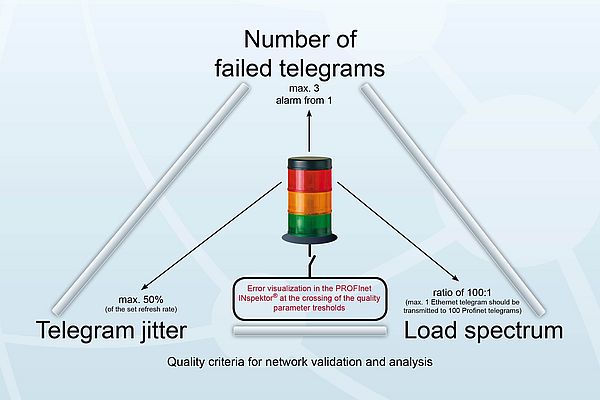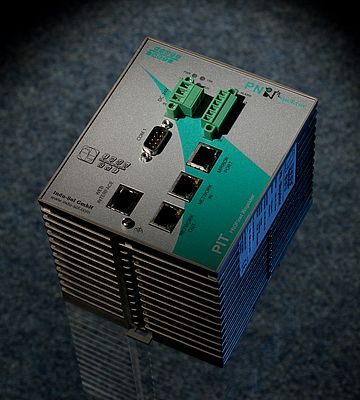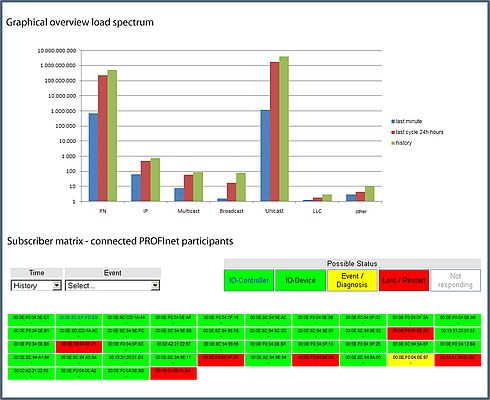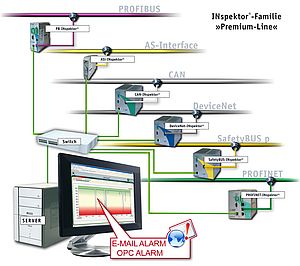Profinet has been developing more and more as communication standard for industrial Ethernet applications. The advantages are obvious: Starting with the fact that all network structures such as ring, star, line or network can be implemented through to a reduced electromagnetic susceptibility by point-to-point wiring Profinet convinces as open, vendor-neutral, international bus standard that enjoys growing user acceptance.
The list of advantages is seemingly endless but a last one should be mentioned at this point. Profinet complements PC-based automation systems in an ideal manner and permits a simple vertical integration from the field level through to the corporate level.
But network communication experts are warning not to approach the issue too unsuspectingly. Karl-Heinz Richter, Managing Director for Marketing & Sales at Indu-Sol GmbH, advises caution and learn from the experiences with Profibus.
One of the major lessons one can learn from the year-long use of Profibus in factory automation is that the mere network function is far from saying anything about the quality of a communication. In other words, just because it is currently known that the communication works, it is impossible to say how good it works and which faults it can bear. Whereas the problems of Profibus are mainly of physical origin, special attention should be paid to the real "load spectrum" because of the possibility to transmit different protocols within one network.
Designing the network properly at the beginning
Although in Profinet the amount of data to be transmitted and the transmission rate appear to be almost boundless compared to Profibus, the communication load of Profinet is not constant making it more difficult to predict a reliable communication. It is therefore necessary to make allowance for the necessary load reserves in advance, and the network structure must be well planned. Similar to road traffic where heavy haulage is not done via B-roads or during rush hours it is important for Profinet to design the communication channels in accordance with the load. A surveillance camera, for example, should be connected directly to the visualization system, or, in order to use the same metaphor, not guided through diverse locations for each passage. Another catchword for planning is "line depth" (cascading of I/O devices). It is necessary to check beforehand whether the line depth fits my application if I want to maintain a certain refresh rate. Applied to the road traffic picture line depth means how many traffic lights and crossovers (switches) respectively have to be passed through on the way to the destination.
Measuring under real conditions
Good planning is one thing but even more important is to know how it is reflected in practice. Richter explains: "There are usually two general reasons why theory does not conform with practice. First, design requirements are often not exactly observed in implementation. So, measurements can help to check design data. Second, it is often impossible in the design phase to consider all contingencies when it comes to complex systems and certain freedom is deliberately granted to the engineer in network design (installation). Therefore the measurement under real conditions can help optimize settings or communication channels." If you want to merge theory and practice, it can be done with reliable measuring results only like network monitoring under production conditions over a longer period of time, e.g. two weeks. Those who do not want to assess the communication quality based on the "LED status display" of the control system or the number of failures, need one thing above all - clear and reasonable quality criteria.
Quality criteria for Profinet communication
In the practical work of Indu-Sol's network experts three network state variables have emerged for Profinet that may well come universal quality criteria in Profinet communication i.e. the telegram jitter, the number of failed telegrams and the load spectrum (e.g. relation of Profinet to TCP/IP).
The jitter indicates the deviation from the refresh rate. Richter explains: "The "jitter" can be compared, for example, with the arrival times of regular service buses. When we expect a bus at an hourly interval and it is sometimes early and sometimes late, we can speak of a deviation from the original time interval, i.e. calling it jittering around the arrival time. In Profinet we set the "arrival time" by the refresh rates. If the time deviates by more than 50 percent, the question Why is definitely permitted or better a Must. From outside, however, the fact of an early problem indication would not be realized."
The second criterion, the recognition of failed telegrams must be seen similar to the "retry limit" with Profibus. The main difference, however, is that telegrams are repeated in Profibus whereas in the Profinet up to three error telegram packages are tolerated without becoming externally visible for the operator.
The third Profinet criterion, the general bus load or traffic, comprises the sum of the entire cyclical and acyclical data traffic. Richter states: "Here too, it is helpful for a better understanding to use a comparison from road traffic - "bus load or traffic". With Profibus there is only one passenger car at a time that goes from A to B or vice versa. With Profinet it is possible to have trucks or motorbikes running on the same road in addition to the passenger cars. For the purpose of assessment it is now important to know at which percentage the individual user adds to the traffic load. A guide value for the load spectrum is a ratio of 100:1, i.e. max. one Ethernet telegram should be transmitted to 100 Profinet telegrams."
A good network planning should also consider in advance which loads may appear when and how to distribute it for a good network utilization. Again Richter cites figures based on experience: "A maximum bus load of 20 percent is in any case enough to ensure a network communication without any unexpected communication failure. Or let us put it this way: Assuming the capacity of the roads of Schmölln where we are based is utilized at 20 percent, a car driver can be sure to have green light wherever he comes from or goes to."
Calibrating lines - a thing of the past
To safeguard the communication reliability of Profibus from the outset, it is common practice to check the physical line quality first. It is important because up to 30 subscribers may be connected to one line with Profibus. In Profinet where 30 lines are alloted to 30 subscribers, this procedure is not only costly but also involves the risk of active interference in the installation by plugging in and off and thus new error sources cannot be excluded. Richter states: "A discussion among experienced planners at the Automotive sector meeting led to no clear majority as regards the Pro and Con of line tests in Profinet". According to Indu-Sol's experience it is possible to do without a line test as acceptance criterion in Profinet if the online test is carried out properly. If the online test shows that the three quality criteria have been met, it can be assumed that the line quality is in order. Conversely, deviations from the quality parameters make errors in the lines visible anyhow. The use of a diagnostic tool, such as the Profinet Inspektor working exactly on the same criteria when it comes to assessing the communication quality obviates the need of costly offline cable tests for acceptance.
On the safe side in the long run
In addition to that the "online check" by the Profinet INspektor has the advantage that all abnormalities are recorded by the web-based visualization and shown with time stamp and real values in an easy to survey manner. It makes it easier to analyse which problems was caused by what. It is thus not only possible to properly plan and design networks from the outset but ensure a reliable communication. It would also be good to use the INspektor after the commissioning measurements that means during the entire life time of the system, as long-term ECG of the system so to say. All changes, especially the unexpected ones, caused by acyclical amounts of data, can thus be safely traced and communication issues avoided.
Richter sums up: "It would be desirable, of course, if plant operators defined the given criteria as quality characteristics in their delivery instructions or as acceptance and test criteria. In the end a long term reliable Profinet communication without unexpected failures or costly plant shutdowns can only be achieved by clearly measurable requirements. I hope the mistakes initially made with Profibus will not be repeated with Profinet, and we will not content ourselves by saying "It's working". Today the existing monitoring and testing facilities including the integrated network diagnoses are capable of giving information on the real network condition at any time. So, it is not the question whether a qualitative network diagnosis is possible or available, but just the question whether and when we make a start.





























